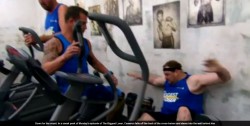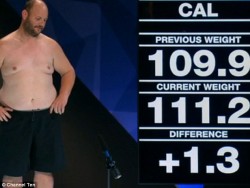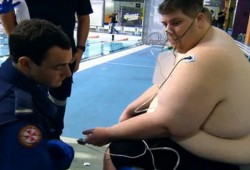Have you ever watched an overweight person be buckled into a harness and forced to pull a truck behind them like a pack animal? Well if you’re a fan of Channel Ten’s The Biggest Loser, you probably have.
Since its Australian premiere in 2006, the extreme weight loss show has grown in popularity and it is now airing its 10th season. But is the tearful and tirade-filled “reality” show a good role model for those at home? Most health, fitness and medical professionals will strongly agree that it’s not. From extreme training programs to ill-mannered treatment of the contestants, The Biggest Loser teaches viewers that the only thing that matters is the number on the scale.
We’d be out of business if we did this.

The first thing most (but not all) Personal Trainers learn is: I WILL NOT HURT MY CLIENT!*
It doesn’t take a Personal Trainer to realize that many of the exercises the Shannon Ponton, Michelle Bridges, Steve “Commando” Willis and Tiffany Hall give contestants unnecessarily extreme and fitness exercises for an inactive or obese client. Just because their TV celebrities, it doesn’t make it right.
If you saw a Trainer in your local Gym or park making a 50 year old morbidly obese client jump up and down a bench without any technique and being yelled and screamed at until they collapsed, what would you think? What about a Trainer pushing client so hard that they collapse and fall of the cross trainer straight into a concrete wall as shown in this picture with one of Shannon Ponton’s clients? What about a Trainer that injures clients each and every year, yet never changes the training style to reduce injuries? You not only wouldn’t train with them, if a friend went somewhere that did that to them you’d be having some strong words with them!
To put the numbers in perspective, out of the 16 contestants each season, we estimate that at least 5 get an injury as a direct result of their Trainer giving them negligent exercises, or an appropriate exercise at a negligent intensity. To put those numbers in perspective, we’ve been in business since 1999, if we injured 30% of our clients every three months we would have hundreds and hundreds of injuries, and we and any other Trainer would go out of business very quickly due to word of mouth and lawsuits! So why do people think it’s okay when a celebrity does it?
Biggest Loser fat-shaming.
While two of the show’s trainers, Michelle Bridges and Steve “Commando” Willis, have given public interviews speaking out against the “unhelpfulness” of fat-shaming, their on-screen personas portray a much different story.
The show’s premise is based on the notion that a fat person, by definition, is unhealthy, unhappy, and unworthy. The Trainers are often shown spewing what they may call “tough love”, but in reality, it’s disrespectful, cruel and downright bullying—all conveying the message that when you’re overweight, you don’t deserve to be treated like a real person.
The entire show comes down to you lose an amount of weight in a week that any professional would call dangerous and unhealthy, and you’re a celebrated as a “winner”, you lose a healthy amount of weight such as 500 grams and you’re frequently considered a “loser”. And if you ever gain weight you’re treated as a “failure”, as Callan Evans was on the left for a one week weight gain, despite amazing losses over a more realistic one month time frame. All while a bunch of strangers watching TV at home judge you on how your fat looks in little more than your underwear. The Biggest Loser Trainers may talk it up about it being more about health and happiness than the scales, but actions speak louder than words!
Biggest Loser “reality?” Get real.
Several past contestants of both the US and Australian versions of the show have since come forward to reveal just how “real” the weekly weigh-ins are. In an interview with News.com.au, 2008 contestant Andrew “Cosi” Costello says, “Have you ever wondered how the contestants manage to lose a staggering 12 kilos in a single week? We don’t. In my series a weekly weigh-in was NEVER filmed after just one week of working out. In fact the longest gap from one weigh-in to the next was three and a half weeks. That’s 25 days between weigh-ins, not seven.”
Making the audience think that contestants are losing 9-15 kilos in one week is not only deceiving, but can be destructive to those watching the show for motivation in their own weight loss endeavors. A person at home may work hard at eating right and exercising for a week and only lose 1 kg. They watch everybody on the show lose 10 times that amount in a week, and now they feel like a failure. What do you do most people do when they feel like a failure? Give up.
Safety doesn’t make for good TV.
A show about people easing into workouts or losing weight in a gradual and safe manner probably wouldn’t make for good ratings. What does captivate audiences is the blood, sweat and tears emitted from The Biggest Loser contestants right from the get-go. The same way a car race is always more exciting when there’s a crash. Whether it be a car or a person, you push it to the extreme, you will break it! The difference is you can replace a car, or parts of a car and make it as good as new. The same can’t be said for extreme physical injuries which may results in life long issues.
In post-show interviews, past contestants have revealed that the trainers and the show’s producers often showed complete disregard for their safety and well-being. A contest on the season three of the US show, Kai Hibbard, told body image coach Golda Poretsky in an interview, “We were working out anywhere between 2 and 5 hours a day, and we were working out severely injured.” She also goes on to say that many of the contestants resorted to dehydrating themselves prior to weigh-ins, and that when the show’s medical professionals did try to intervene, “the crew or production would step in and tell us that we were not to listen to anybody except our trainers.”
254kg contestant Kevin Moore is just one of many examples who required medical attention for heart palpitations due to being pushed beyond a safe level on a treadmill. Just as a car crash pulls in more viewers, Channel 10 pulled in more viewers by splashing something that could have killed him across their TV ads. We personally think his health and safety is more important than TV ratings.
Dramatic and extreme? Yes. Sustainable? Nope.
Viewers of the show often get caught up the drama of the shocking transformations that occur in just a matter of months—and granted, this is exactly what the show’s producers are banking on. But what we may be forgetting is that extreme weight loss in a short amount of time can be fairly easy to obtain in a controlled environment. Not only were the contestants’ workouts and calorie intake monitored, but also their access to mass media and contact with friends and family. You take out all of the guesswork and any of life’s usual distractions, and just about anybody can lose a significant amount of weight in a few weeks.
But what happens when you’re back in the real world? You know, the one without Shannan Ponton shouting in your ear, or all of your calorie-stripped meals specially prepared for you? Suddenly you have to deal with work, and holidays, and temptation. Your weight loss slows, and eventually plateaus, and you likely start to gain much (if not all) of that weight back. Weight loss of that significance, done in such an extreme manner, is simply unsustainable—and unhealthy.
The biggest problem of all: The example it sets for viewers!

Don’t be scared off by Personal Trainers. The best ones will not force you to run 10,000 steps until you collapse!*
Despite all our criticism we realize that the contestants are grown adults who can make their own decisions to go on the show, it’s not our place to tell them off. The biggest issue we have is the terrible example the show sets for hundreds of thousands of viewers it influences. While we can appreciate that the show provides good inspiration for many viewers, and simply entertainment for others, it’s not the case for everyone. The obesity epidemic is getting worse and worse (partially due to to people failing on extreme diets), eating disorders are more common than they’ve ever been, body image issues are getting worse, physios are reporting a rise in injuries from extreme and negligent exercises. Not to mention the effect that it has on easily influenced people, especially teenagers, struggling with their weight and other body issues. Watching the show does little for their self esteem when it is constantly reinforced that they are a “loser” if they only lose a few hundred grams in a week, and nobody feels like working out and eating healthy when they feel like a “loser”.
So don’t take advice from reality shows that reinforce that if there’s “no pain there’s no gain” and that weight loss is about deprivation. Don’t be scared off Personal Training by four Trainers that don’t represent the level of safety and comfort thousands of great Trainers in Australia offer. And let’s stop reinforcing that someones self worth is based on the number the scales say and focus on health, happiness and living life to the fullest thanks to safe, enjoyable and effective exercise and nourishing and balanced meals! Follow this safer approach and the long term results can be just as amazing as The Biggest Loser contestants who keep it off. Shari is one of our clients who did and lost 100kg, and she happily did it injury free!
*All images copyright Network Ten and The Biggest Loser






